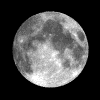|
The Nazarene Way of Essenic Studies |
 |
|
The Nazarene Way of Essenic Studies |
 |
moon phases
Brief Explanation of the Moon Phases
The phases of the moon are caused by the relative positions of the earth, sun, and moon. The moon goes around the earth, on average, in 27 days 7 hours 43 minutes.
The sun always illuminates the half of the moon facing the sun (except during lunar eclipses, when the moon passes thru the earth's shadow). When the sun and moon are on opposite sides of the earth, the moon appears "full" to us, a bright, round disk. When the moon is between the earth and the sun, it appears dark, a "new" moon. In between, the moon's illuminated surface appears to grow (wax) to full, then decreases (wanes) to the next new moon.
The edge of the shadow (the terminator) is always curved, being an oblique view of a circle, giving the moon its familiar crescent shape. Because the "horns" of the moon at the ends of the crescent are always facing away from the setting or rising sun, they always point upward in the sky.FULL MOON NAMES
A full moon appears as an entire circle in the sky. The full moon is given different names, depending on when it appears. For example, the "Harvest moon" is the full moon that appears nearest to the Autumnal Equinox, occurring in late September or early October. Some other full moon names (by month) include:
January Moon After Yule, Wolf Moon, or Old Moon
February Snow Moon or Hunger Moon
March Sap Moon, Crow Moon, or Lenten Moon
April Grass Moon or Egg Moon
May Milk Moon or Planting Moon
June Rose Moon, Flower Moon, or Strawberry Moon
July Thunder Moon or Hay Moon
August Grain Moon or Green Corn Moon
September Fruit Moon or Harvest Moon
October Harvest Moon or Hunter's Moon
November Hunter's Moon, Frosty Moon, or Beaver Moon
December Moon Before Yule or Long Night Moon
The Nazarene Way
of Essenic Studies
Email us at: Comments@TheNazareneWay.com
Join our Essene
Holy Communions email list
Sign
our Guest Book!